The demand for acrylic and lacquer kitchen cabinets has increased among homeowners. The trend is mainly attributed to their durability and aesthetic appeal.
According to research, the global lacquer market will increase at a CAGR of 5.2% from 2022 to 2032. Moneywise, the study shows an increase from USD 30,904 to 45,349 million in 2022 and 2032, respectively.
These two cabinet finishes provide a sophisticated and modern look for your kitchen. They are symbols of optimum functionality, elegance, and durability.
Additionally, they both present homeowners with various colors to choose from.
But what are the key differences between the two?
To help you understand better, we have compared seven key areas. At the end of this article, you should have a clear picture of each of these finishes and be able to make your choice.
Read on to the end.
JUMP TO: Table Comparison | Acrylic Kitchen Cabinets | Lacquer Kitchen Cabinets | Acrylic vs. Lacquer |
Key Take Away
- Acrylic and lacquer have both an aesthetic appeal
- They both have a wide variety of colors
- Acrylic takes 20 minutes to dry, while lacquer takes less than 20 minutes
- Both are good in durability
- Acrylic is easier to clean than lacquer
- Lacquer is more pocket-friendly than acrylic
Table Comparison
| Parameters | Acrylic | Lacquer |
| Aesthetics | Aesthetically appealing | Aesthetically appealing |
| Color and varieties | comes in a wide variety of colors | comes in a wide variety of colors |
| Maintenance | Easy to clean | Slightly difficult to clean |
| Durability | Highly durable | Durable but slight scratches can expose the wood surface |
| Cost | Quite expensive | Pocket-friendly |
| Toughness of the surface | The surface may flake and chip with time | The surface is quite sturdy and hardly flakes |
| Ease of Drying | Takes 20 minutes to dry | Dries in only 10 minutes |
Acrylic Kitchen Cabinets – Explained
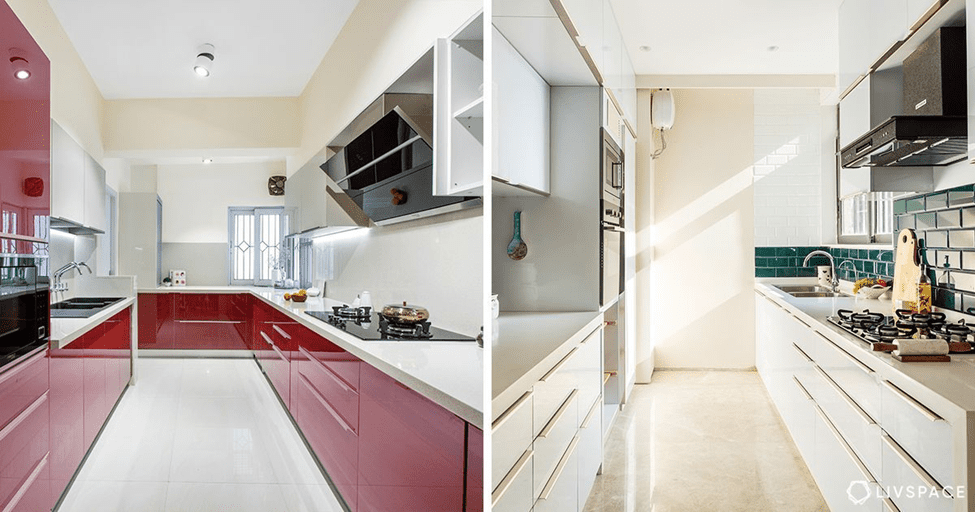
Source:livspace.com
Is your kitchen dull and boring?
You can brighten it up by adding high-gloss acrylic kitchen cabinets!
Acrylic is a non-toxic, reflective finish that gives kitchen cabinets a high-gloss appearance and an exceptionally smooth texture. This synthetic material is produced in sheet form and has a premium mirror-like finish.
It is a typical alternative to laminate or glass. Thanks to its remarkable visual appeal. Acrylic is also available in a wide range of sizes and colors.
Types of Acrylic cabinets
There are two primary types of acrylic cabinets:
- Solid acrylic doors
- Acrylic faced doors
Solid acrylic doors are entirely acrylic, meaning they have a richer, more even appearance and a vibrant look. Consequently, they are more expensive.
On the other hand, acrylic-faced doors are simple acrylic sheets applied to an MDF board using an adhesive. Then, the sheets are sealed at the edges with protective layers or edge bands.
Acrylic-faced doors are cheaper than solid acrylic doors.
Pros
- Very durable and reliable
- Available in a variety of colors
- Brilliant texture and colors
- Waterproof
- Retains its original hue and brightness for so long
- Easy to clean
- UV resistant
Cons
- Stains, dirt, and fingerprints are easily visible
- More expensive compared to other finishes
- DIY is not the best option – you’ll need an expert to install
- Difficult to replace
Lacquer Kitchen Cabinets – Explained
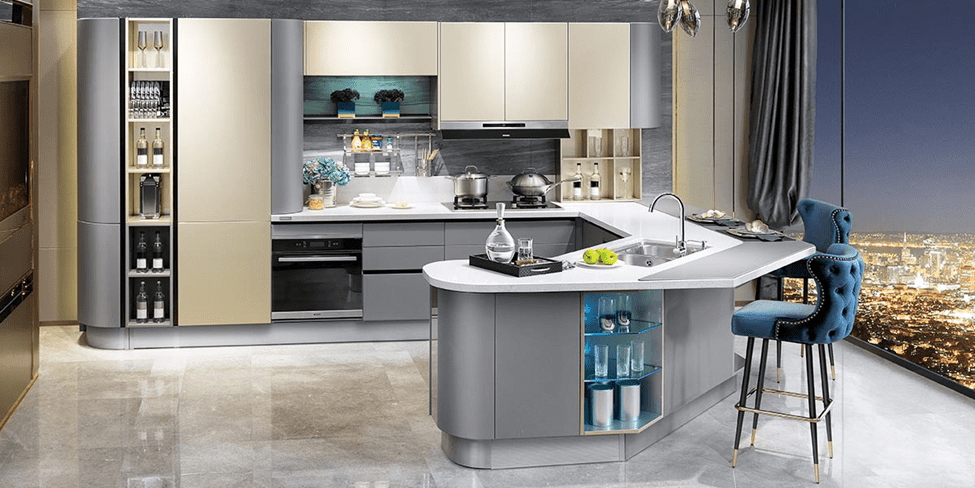
Source:oppeinkenya.co.ke
The lacquer finish is one of the most significant trends in kitchen cabinetry. Besides offering a unique texture, the lacquer finish creates contrast and a visual impact in your kitchen.
Lacquer creates a synthetic coating on the cabinet surface, resulting in a high-gloss shine. It can either be clear or colored.
Types of lacquer
Lacquer comes in four different types:
Nitrocellulose Lacquer
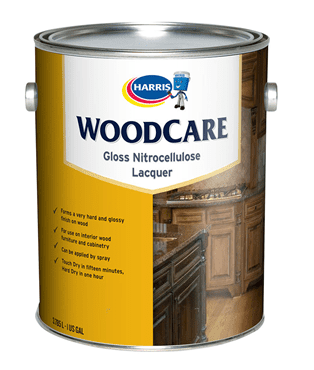
Source: championsofcolour.com
This finish is the most commonly used. It works well on wooden products and dries quickly. Unfortunately, nitrocellulose lacquer is highly toxic, hazardous, and flammable. It also yellows as it ages.
Acrylic Lacquer
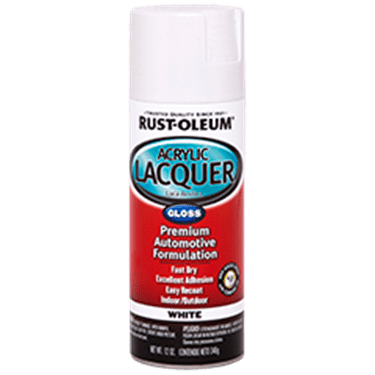
Source: rustoleum.com
This lacquer is made from a non-yellowing formula, thus perfect for light-colored kitchen cabinets. It also dries up pretty fast.
Catalyzed Lacquer
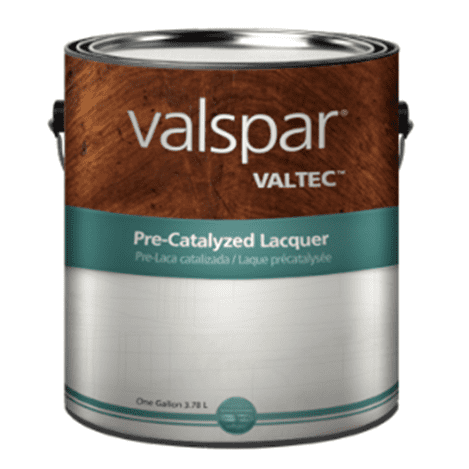
Source:hirshfields.com
There are two types of catalyzed lacquer:
- pre-catalyzed lacquer and
- post-catalyzed lacquer.
The former comes pre-mixed upon purchase, while the latter requires the purchaser to mix the two-part product themselves.
Once mixed, catalyzed lacquer has a short window period within which it must be used. Many professionals and homeowners love this lacquer because it is highly durable.
Related Read: Should Wall Color Match Kitchen Cabinets?
Water-Based Lacquer

Source: ardec.co
Water-based lacquer is the most preferred for refinishing kitchen cabinets. It is the most environmentally friendly compared to all other lacquer types. Besides, it is durable, scratch-resistant, and water-resistant.
Pros
- Highly durable
- Resistant to damages resulting from water, acid, and abrasions
- The finish dries quickly upon application
- It comes in different sheens
- It offers a smooth, seamless look
- You can re-coat lacquer cabinets before they start fading to preserve their appearance.
Cons
- Scratches, dents, and other imperfections are easily visible
- Prone to staining after years of use
- May blotch once dry if it was not correctly applied
- Require frequent refinishing
7 Key Differences Between Acrylic and Lacquer Kitchen Cabinets
Aesthetics
Premium high-gloss acrylic finish is among the most preferred kitchen option by many homeowners. It gives your kitchen an inviting appeal and adds visual space.
Additionally, the acrylic finish creates an elegant atmosphere thanks to its highly reflective surface.
Do you intend to make your kitchen cabinets the focal point of your kitchen?
If yes, an acrylic cabinet finish would be the perfect finish.
Lastly, an acrylic finish gives you a beautiful contrast with various backlash options.
A lacquer finish is also aesthetically beautiful and glossy. Moreover, its beauty lasts for a long time. It’s good for bringing the natural beauty of wood grains.
Verdict: Both acrylic and lacquer finishes are excellent in giving your cabinets an aesthetic appeal.
Color and Varieties
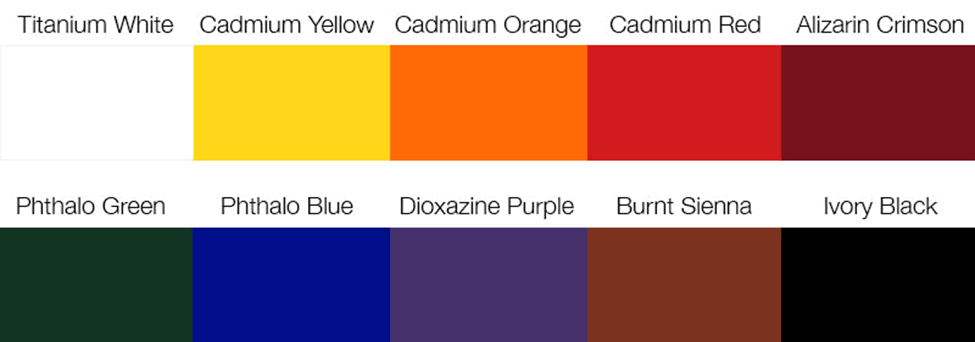
Source:art-is-fun.com
Acrylic kitchen cabinet finishes come in a wide variety of colors. You can opt for versatile neutrals or bright, lively hues.
Is customization your number one priority?
If so, acrylic-painted cabinets allow you wide options of vibrant shades to choose from. Moreover, these shades retain their brightness and color for many years.
Additionally, acrylic finish color varieties are ideal whether your kitchen has a modern or traditional interior theme. Thanks to the many available color varieties, you can get an ideal color complement for interior style.
Likewise, lacquered kitchen cabinets come in a variety of colors. However, bright-colored lacquer finishes for your kitchen stand out uniquely.
Verdict: Both lacquer and acrylic cabinet finishes offer you a variety of colors that you can choose from to complement your kitchen interior.
Maintenance
Acrylic kitchen cabinet finishes are scratch-resistant. Additionally, they hardly fade over time. They don’t de-laminate or tarnish; thus, they keep their glossy and smooth appearance for years.
However, the glossy surface makes every tiniest fingerprint, stain, or scratch easily visible. Darker shades of acrylic finishes are particularly affected by any tiny defect.
Consequently, acrylic finishes call for regular cleaning to maintain the mirror-like shine.
The good news, however, is that acrylic finish cabinet doors are easy to clean. All you need is soap and water; plus, you need not worry about inhaling toxic chemicals.
Lacquer, just like acrylics, catches stains easily and requires frequent cleaning. However, unlike acrylic, it’s slightly difficult to clean.
Verdict: Although both lacquer and acrylic catch stains easily, acrylic is easier to clean. As such, it fairs better when it comes to maintenance.
Durability
Many homeowners see acrylic finish cabinets as highly durable. They maintain their color and gloss for many years and don’t lose their charm because of direct sunlight.
Moreover, acrylic is resistant to chipping and cracks. The durability can be attributed to high-quality, hard plastic resins.
Lacquer kitchen cabinets are also durable, with some homeowners saying they last for years. They are highly resistant to any damage, especially from water, acid, abrasions, and alkalis.
The only challenge with lacquer finishes is that trying to remove them can damage the surface. Moreover, scratches can easily expose the wood surface.
It’s for this reason that many users appear to express reservations when it comes to lacquer cabinets.
Verdict: According to reviews from many users, acrylic cabinets are more durable than those made of lacquer.
Cost
Acrylic cabinets are among the most expensive in the market. The high cost can be attributed to their aesthetic appeal and as well as ease of cleaning.
Generally, the cost of acrylic kitchen cabinets ranges from $5,000 to $20,000 or more.
On the other hand, the cost of lacquer cabinets begins from as low as $1,500 up to $6,000. Despite this cost, they still meet the aesthetic appeal required by many homeowners.
Verdict: Lacquer kitchen cabinets are more cost-friendly than acrylic cabinets.
The toughness of the surface
Lacquer kitchen cabinets are among the toughest you will find in the market. According to user reviews, they have a tough surface that can last very long without flaking or chipping. Moreover, lacquer kitchen cabinets can stay for years without yellowing.
On the other hand, the acrylic finish is quite sturdy. However, user reviews show that it easily peels, chips, and flakes after drying. Users also observe that the acrylic flakes are quite brittle.
Verdict: Lacquer kitchen cabinets fare better than acrylic when it comes to the toughness of the surface. They hardly flake and hardly turn yellow.
Ease of Drying
Lacquer finish takes a very short time to dry. On average, lacquer dries in as little as 15 minutes under room temperature. Consequently, you can spray several coats in a single day.
Acrylic ease of drying depends on the width of the film. Thin acrylic films take between 20 to 30 minutes to dry completely. However, thicker films take longer, maybe an hour or two.
Take note that environmental conditions also play a major role in the speed of drying of any cabinet finish.
Verdict: Lacquer finish is the better option if you want a finish that dries fast.
Wrapping it up
If you aren’t sure what to choose between acrylic and lacquer, consider the characteristics mentioned above. They will be helpful in enabling you to make a choice.
For some homeowners, aesthetic appeal and durability might be their first considerations. However, others may prefer to go for ease of maintenance, cost, or toughness of the surface.
However, your final choice will ultimately boil down to your likes and preferences.
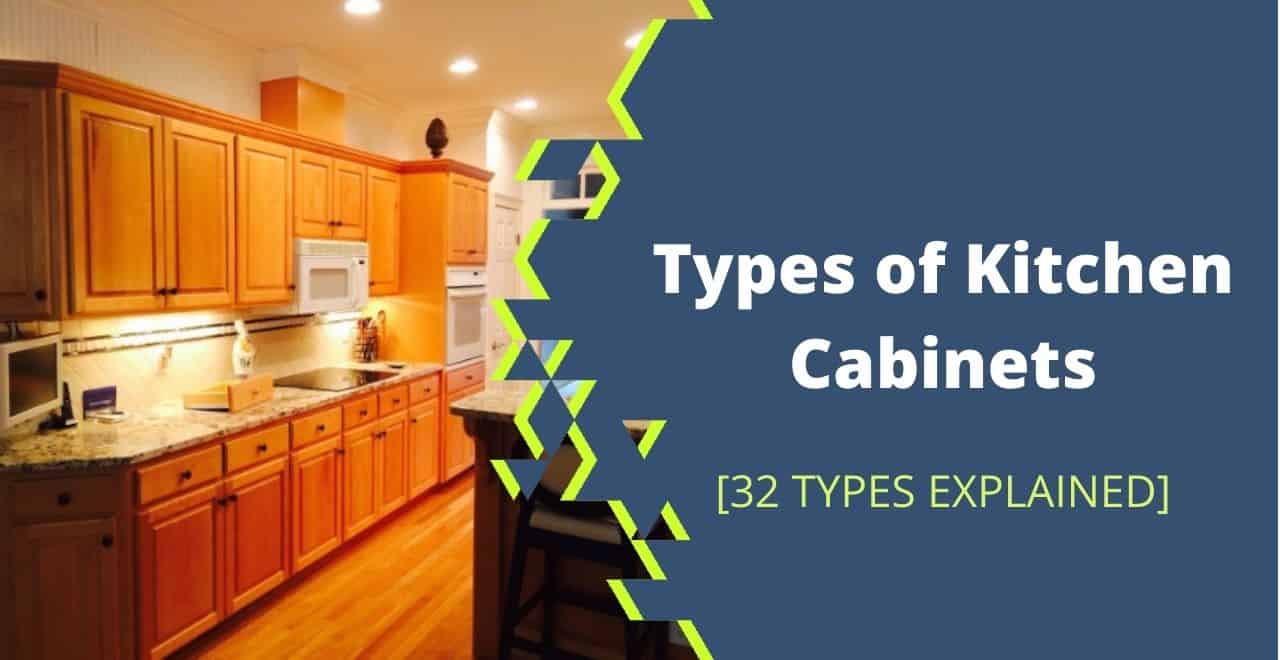
![16 Types of Kitchen Cabinet Finishes [Features + Pros & Cons] 16 Types of Kitchen Cabinet Finishes [Features + Pros & Cons]](https://houseadorable.com/wp-content/uploads/2022/10/cabinet-finish.jpg)
![What Are Kitchen Sinks Made Of ? [13 Types+Pros & Cons] What Are Kitchen Sinks Made Of ? [13 Types+Pros & Cons]](https://houseadorable.com/wp-content/uploads/2022/01/Sink-MAterial.jpg)
![Granite Vs. Marble Vs. Quartz Countertops [12 Differences+Pros & Cons] Granite Vs. Marble Vs. Quartz Countertops [12 Differences+Pros & Cons]](https://houseadorable.com/wp-content/uploads/2022/03/quartz-marble.jpg)
![Gloss Vs. Matte Kitchen Cabinets [7 Key Differences Explained] Gloss Vs. Matte Kitchen Cabinets [7 Key Differences Explained]](https://houseadorable.com/wp-content/uploads/2022/12/white-high-gloss.jpg)
![How to Choose Kitchen Cabinets [9 Important Tips Included] How to Choose Kitchen Cabinets [9 Important Tips Included]](https://houseadorable.com/wp-content/uploads/2022/10/kitchen.jpg)
![How Long Does it Take to Install Kitchen Cabinets? [Steps Explained] How Long Does it Take to Install Kitchen Cabinets? [Steps Explained]](https://houseadorable.com/wp-content/uploads/2022/07/kitchen-cabinet-installation.jpg)
![Should Wall Color Match Kitchen Cabinets? [Tips+Tricks Included] Should Wall Color Match Kitchen Cabinets? [Tips+Tricks Included]](https://houseadorable.com/wp-content/uploads/2022/09/kitchen.jpg)